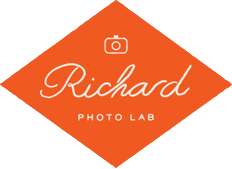Metering 101 for Film Photography
When you're putting together your film photography tool kit, you've of course got your camera, your favorite 35mm film or medium format film, your camera strap and bag, some lens options, maybe even an off-camera flash... what's missing? A light meter, of course! Hopefully you own one and use it religiously, but if not, keep reading because this blog post is for you.
As a professional film lab doing a TON of film developing and film scanning on a daily basis, we are all too familiar with seeing underexposed and extremely overexposed negatives (sometimes all on the same roll). This can lead to less than desirable results in scanning and an even more unhappy photographer who receives those scans. It’s bad news all around, and as your lab, we 1) never want you to be unhappy or discouraged with shooting film but 2) want you to know the power that using a light meter has to give you amazing, consistent, and replicable.
So, this is where you sit back and let us be the Yoda to your Luke Skywalker and show you the power of "the force" that is using a light meter…
What is metering light exactly? This refers to the technique you use to measure the amount of light in your scene, which will then guide your camera setting for yielding the correct exposure. A light meter converts the light it is seeing to middle grey or the halfway point between clear/unexposed film and DMAX (the maximum density of an exposed film negative), thus giving you the scientifically “ideal” exposure reading.
Why is metering so critical? Because light is literally how an image is recorded onto your physical film. Shooting film without metering is like painting without looking at your palette of colors when you dip your brush in it. Beyond that, metering gives you consistency. Imagine having to replicate that painting that you blindly picked paint for—YIKES!
There are three different metering methods you can use for your film photography...

The first is an incident meter, which measures the amount of light that is falling on your subject using a lumisphere (white dome or bulb) to “see” the light. To execute this method, you place the meter in front of your subject and point it in the direction of the camera. The bulb of the meter should be pointing back at the camera, so it is measuring all the light that your camera is seeing. This is the preferred metering method for photographing people and close-up subjects.
Now, the question we get all the time regarding incident meters is “bulb in or bulb out?”. This question is referring to if the bulb of the meter should be extended out or should be tucked in. "Bulb in" is a sneaky way of tricking your light meter by making the bulb less visible to light and thus giving you a reading resulting in overexposure of your film. While we recommend using a light meter "bulb out" because you are maximizing the amount of the light that is being averaged in your sceen, it ultimately doesn't matter which you choose just as long as you choose it consistently. Consistency is KEY when metering—that is the only way you can control and replicate your results.

Handheld spot metering measures the amount of light reflecting off of a specific spot in a scene using a one-degree circular scope meter. It is great for photographing landscapes or other subjects that are far away from the camera. This method gives you the ability to meter your shadows, midtones, and highlights independently and then determine the best exposure for the type of image you are trying to capture. If that last sentence sounds like the Zone System, you are correct! A one-degree spot meter is the only way to properly conduct the Zone System (made famous by the great Ansel Adams—see more on that here).

Lastly, there’s the in-camera reflective meter, which is built inside your camera and averages the reflected light in your scene. It’s similar to a spot meter, but not as precise. This meter does best with mild lighting situations that have no dramatic shadows or highlights. In a pinch, this method is better than nothing, but it’s still recommended to use an external meter for the most accurate readings.
Just like with other variables in photography, you’ll want to remain consistent in the way that you meter (right down to the way you hold it) to understand the role it plays in the appearance of your final images.
Light meters are used in both analog and digital photography, but they are supremely beneficial for film photographers because of the obvious—we have no screen to show us instant exposure results! It can be a hard pill to swallow working without the comfort of a screen to show you what you are doing, but we choose to look at it differently. Without a screen you have to really know and understand the process, and knowledge is POWER (#filmschoolhouserock). And your best friend in that knowledge/power tool box is your light meter.
To continue on the questionable pop culture comparison path, it is the Robin to your Batman. Are we clear!? In order for a film photographer to know what exposure readings to plug in for their shutter speed and aperture, you've gotta use a light meter. If you don’t, then you are just guessing... and sometimes you can get lucky and it works out, but that will come back to bite you in the behind at some point in your career. Trust us, we have seen it with some of the most seasoned film photographers out there.
The forgiving nature of film is pretty awesome. Film has a LOT of exposure latitude. It renders creamy and detailed-filled highlights while still keeping shadow details, and oh, have we mentioned how beautiful skin tones are on film? It really is a magical medium to work in. But this forgiving nature can make you overconfident about exposure and maybe even doubt the need to use a light meter at all, But not using a light meter leads to inconsistent negatives and inconsistent negatives leads to inconsistent scans.
The proactive steps you take to control your image in camera will radiate through the rest of the development chain and give you #dreamscans #allthetime.
METERING CHEAT SHEET
While we strongly urge you to experiment and really get an understanding of how to meter for film scans that you love, this cheat sheet can help guide you on how to meter in different scenarios:
How to Meter a Subject in Mixed Strong Light (lots of harsh light & shadows):
- Use an incident meter bulb out.
- Meter a part of the scene that shows both light and shadows so you get a true average reading.
- Meter should be pointed at camera.
Meter a Subject in the Sand/Snow:
- Use an incident meter bulb out.
- Meter the light falling on the subject of your shot.
- Place your free hand underneath the bulb to block any reflective light casting upward from the bright sand or snow.
- Meter should be pointed at camera.
How to Meter a Subject in the Shade:
- Use an incident meter bulb out.
- Expose for light falling on your subject.
- Optional: overexpose 1-2 stops to add more exposure and saturation to your film to compensate for the shade.
- Meter should be pointed at camera.
How to Meter in Bright Sun:
- Use an incident meter bulb out.
- For a more "dramatic" look, expose for the bright light that is falling on your subject (this may cause you to have no details in your shadows).
- To get more average overall tones, meter between the bright sun and darkest shade of your scene.
BUYING A LIGHT METER
If you are looking to buy a brand new light meter, it's tough to go wrong with Sekonic meters. But you do't have to drop a lot of cash to get a good meter—check out Ebay or other secondhand sites and look for brands like Pentax, Minolta, and Sekonic.

